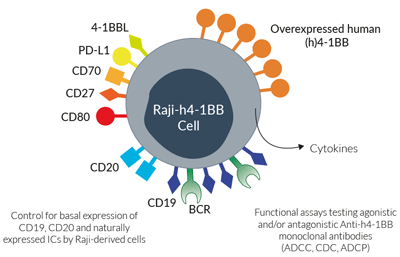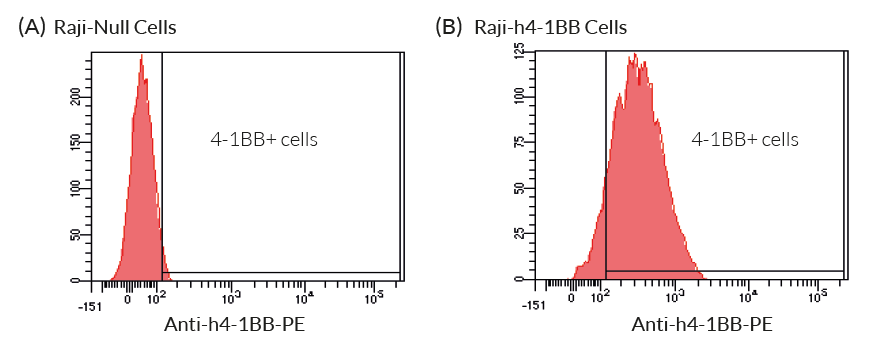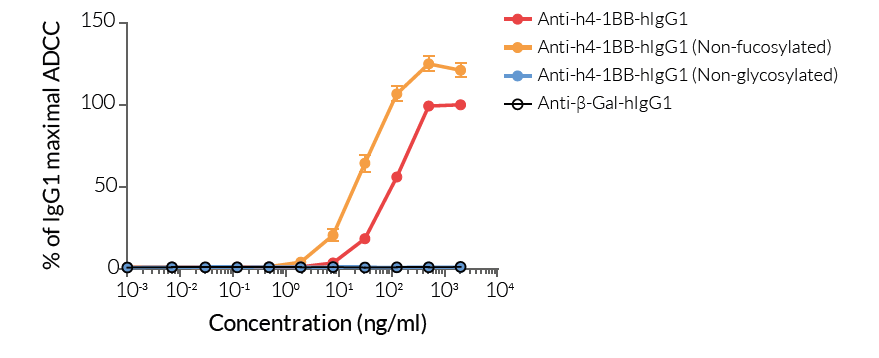Human 4-1BB-expressing Raji Cells
| Product | Unit size | Cat. code | Docs. | Qty. | Price | |
|---|---|---|---|---|---|---|
|
Raji-h4-1BB Cells Human lymphoblast cells - ADCC 4-1BB Target Cells |
Show product |
3-7 x 10e6 cells |
raji-h41bb
|
|
||
|
Raji-h4-1BB vial Additional cell vial |
Show product |
3-7 x 10e6 cells |
raji-h41bb-av
|
Notification: Reference #raji-h41bb-av can only be ordered together with reference #raji-h41bb.
Human 4-1BB-expressing B cells
Raji-h4-1BB cells were developed from the human Raji cell line, a human B lymphocyte-derived cell line, and engineered to stably overexpress the human 4‑1BB gene. Raji cells have been successfully used as target cells in antibody effector studies such as antibody-dependent cellular cytotoxicity (ADCC) and antibody-dependent cellular phagocytosis (ADCP) assays with peripheral T cell-derived Jurkat reporter cells.
4-1BB (also known as CD137 or TNFSF9) is a co-stimulatory immune checkpoint (IC) receptor that belongs to the tumor necrosis factor receptor (TNFR)/TNF superfamily. 4-1BB is expressed on a multitude of cells including activated CD8+ and CD4+ T cells [1]. Upon 4-1BB binding to its ligand, 4-1BBL (CD137L), expressed on antigen-presenting cells (APCs), NF‑κB‑dependent signaling is activated within the T cell, powerfully augmenting T cell activation, proliferation, and survival [1]. Notably, activation of 4-1BB has the capacity to mediate strong effector T cell immune responses and thus, makes it an attractive target for cancer immunotherapy [1,2]. Despite 4-1BB agonistic antibodies eliciting potent anti-tumor responses, monotherapy progress has been limited in the clinic [2]. However, combinational therapies may be promising with a significant synergistic effect observed when used in combination with IC inhibitory antibodies (e.g. Anti-CTLA-4 and Anti-PD-1) [1,2].
Features of Raji-h4-1BB cells:

Surface expressed markers and ICs in Raji-h4-1BB cells
- Stable overexpression of the human 4-1BB gene
- Characterized by a number of cell-surface expressed markers including the B cell receptor (BCR), CD19, and CD20
- Constitutive expression of various immune checkpoints (ICs) such as CD27, CD70, CD80, PD-L1, and 4-1BBL
Applications for Raji-h4-1BB cells:
- Target cell line for ADCC and ADCP assays using InvivoGen's Jurkat-Lucia™ NFAT-CD16 cells and Jurkat-Lucia™ NFAT-CD32 cells, respectively.
- Target cell line for cell toxicity assays using NK or CAR-T cells
- For use in the development novel human 4-1BB mAbs
Validation of Raji-h4-1BB cells:
- Overexpression of 4-1BB verified by flow cytometry
- Functionally tested as target cells in ADCC assays using anti-human 4-1BB mAbs and Jurkat-Lucia™ NFAT-CD16 cells
- Guaranteed mycoplasma-free
References:
1. Bartkowiak, T. & Curran, M.A. 2015. 4-1BB Agonists: Multi-Potent Potentiators of Tumor Immunity. Front Oncol 5, 117.
2. Ascierto, P.A. et al. 2010. Clinical experiences with anti-CD137 and anti-PD1 therapeutic antibodies. Semin Oncol 37, 508-516.
Specifications
Antibiotic resistance: Blasticidin
Growth medium: IMDM, 2 mM L-glutamine, 25 mM HEPES, 10% heat-inactivated fetal bovine serum (FBS; 30 min at 56 °C), Pen-Strep (100 U/ml-100 µg/ml), 100 µg/ml Normocin™
Test medium: IMDM, 2 mM L-glutamine, 25 mM HEPES, 10% heat-inactivated FBS, Pen-Strep (100 U/ml-100 µg/ml)
Quality control:
- Expression of human 4-1BB has been verified by flow-cytometry.
- Induction of antibody-dependent cellular cytotoxicity (ADCC) has been validated using anti-h41BB antibodies and InvivoGen's Jurkat-Lucia™ NFAT-CD16 cells reporter cell line.
- The stability for 20 passages following thawing has been verified.
- Raji-h4-1BB cells are guaranteed mycoplasma-free.
Contents
- 3-7 x 106 Raji-h4-1BB cells in a cryovial or shipping flask.
- 1 ml of Blasticidin (10 mg/ml). Store at 4 °C or at -20 °C.
- 1 ml of Normocin™ (50 mg/ml). Normocin™ is a formulation of three antibiotics active against mycoplasmas, bacteria, and fungi. Store at -20 °C.
IMPORTANT: If cells are shipped frozen (i.e. in a cryovial) and are not frozen upon arrival, contact InvivoGen immediately.
![]() Shipped on dry ice (Europe, USA & Canada)
Shipped on dry ice (Europe, USA & Canada)








